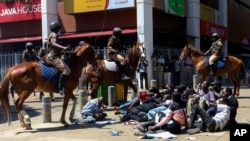Since June 2024 — when a series of mass protests took place in Kenya — 82 cases of alleged forced disappearances were recorded by the Kenya Human Rights Commission.
Rights groups say some of those alleged victims have been lucky to reunite with their loved ones, but 29 are still missing. While many accuse the police of perpetrating such acts, it's yet to be confirmed who’s behind the abductions.
VOA requests for comments from the National Police Service were not answered.
Aslam Longton and his brother, Jamil, told VOA they were abducted near their home in the Kitengela Town neighborhood, about an hour from central Nairobi.
Earlier that day in August, Aslam said, he felt uneasy and noticed unfamiliar people watching his every move. The brothers were riding together by car when things unraveled.
“At the first corner, there was a Toyota Vitz parked there and opened all the doors, so I couldn't pass there. I reversed the car and came to this place [where VOA was conducting the interview]. When I entered this place, there was a Subaru that came and blocked me here and a Toyota Axio blocked me behind there,” Aslam recalled.
The brothers alleged they were approached by heavily armed men they described as appearing to be police officers and told to switch off their car.
Aslam then said “they opened the car, removed me at the steering [wheel], took me very fast in the Subaru. So, my brother started asking them, who are you? Why are you taking my brother?”
Jamil Longton said he was not meant to be taken away that day, but when he pressed the officers, even suggesting to call the neighborhood police station, they refused to identify themselves.
“I kept on asking them who are you, why are you taking my brother? I must go with my brother wherever you are taking him. I told them I’ll call the OCS [Officer Commanding Station] at the Kitengela police station to ask him if he’s aware of what you are doing. ... When I attempted to call the OCS, my phone was confiscated by them. I was slapped, my phone switched off and I was also bangled [bundled] into the Subaru,” he also recalled.
The brothers say they were handcuffed, blindfolded, taken to a location, and held there for 32 days.
Amnesty International and the Kenya Human Rights Commission confirm the accounts by the two men and say it’s similar to the treatment of other abductees.
“They were telling us they were denied food. They were kept in handcuffs for days. They were stripped naked and were made to lie on concrete floors for days,” KHRC’s Ernest Cornel told VOA.
Aslam said he was abducted because of his participation in the nationwide, youth-led, GenZ protests last year against a proposed bill that would have increased taxes. The protests expanded into a call for an end to corruption and for the president to resign. The bill was eventually withdrawn.
Aslam’s brother did not take part in the protests, but they said they were both repeatedly questioned about its funding source during their captivity.
Rights groups accused the Kenyan police of using excessive force against protesters, in some cases abducting government critics. Police deny the allegations. The police also said they had credible evidence criminal gangs had infiltrated the protests and planned to take advantage.
About 60 people died and hundreds were arrested. Since last June, 82 people have gone missing and about 29 are still not accounted for, the rights organization said.
In December, following more protests in Nairobi to demand the police produce the missing people, President William Ruto condemned the spike in disappearances, saying “any criminality must be investigated. Whether undertaken by citizens, criminals or undertaken by the police, it must be investigated, and we must get to the bottom of any criminal activity in Kenya.”
Meanwhile, at a recent press conference convened by KHRC, some of the victims, including Aslam and Jamil, said that after their release, they still are being intimidated and called for international investigations.
“They are saying that when they go to [for a] run in the morning, they can see the car following them. They can see cars parked outside of their homes with their engines running and with their lights on and when they confront the occupants of the car, they sped off,” Cornel says.

